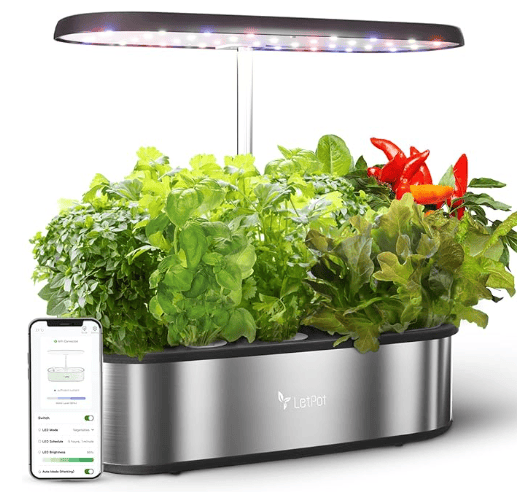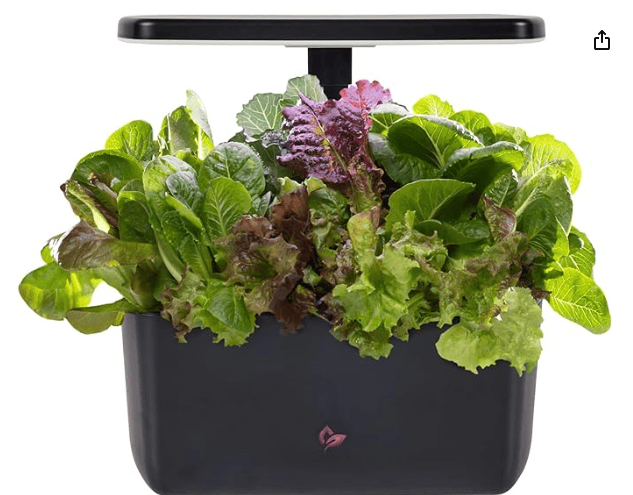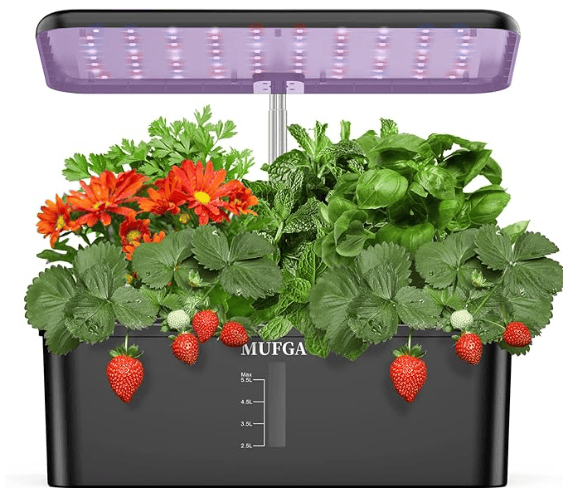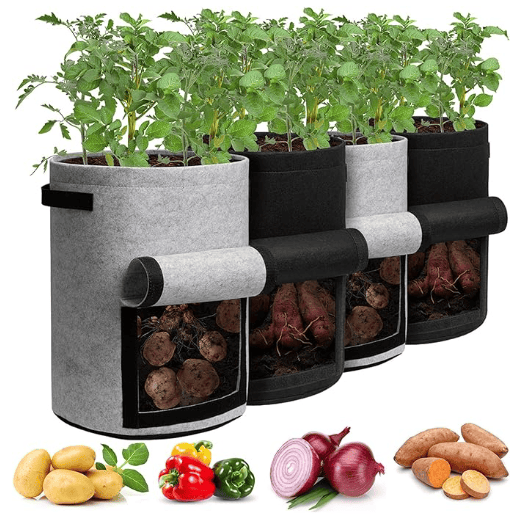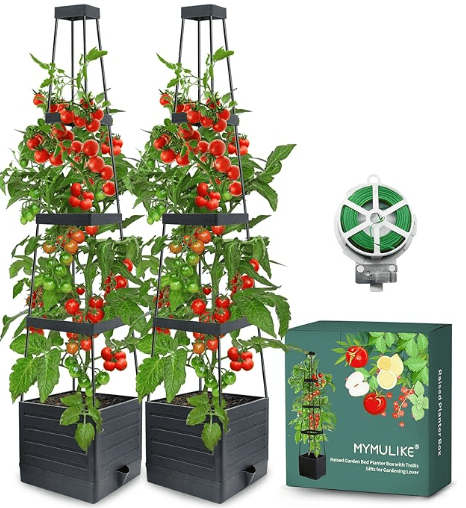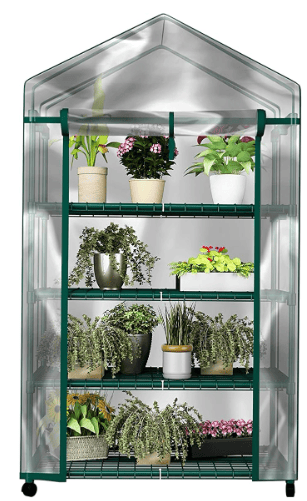Indoor Container Gardening [Tips & Ideas]

Indoor container gardening is a transformative approach to cultivating plants that merges convenience with versatility.
Perfect for urban dwellers, those with limited outdoor space, or anyone looking to add a bit of greenery to their indoor environment, this method allows for growing a variety of plants, from lush vegetables and succulent fruits to aromatic herbs, all within the comfort of your home.
This guide explores the fundamentals of indoor container gardening, introduces the best systems and species for indoor cultivation, and provides practical tips to ensure your indoor garden thrives.
Whether you are a seasoned gardener or a curious beginner, this guide will equip you with all you need to start your own indoor garden to grow your own vegetables indoors, fruits, or easy herbs.
Chapters
What is Indoor Container Gardening?
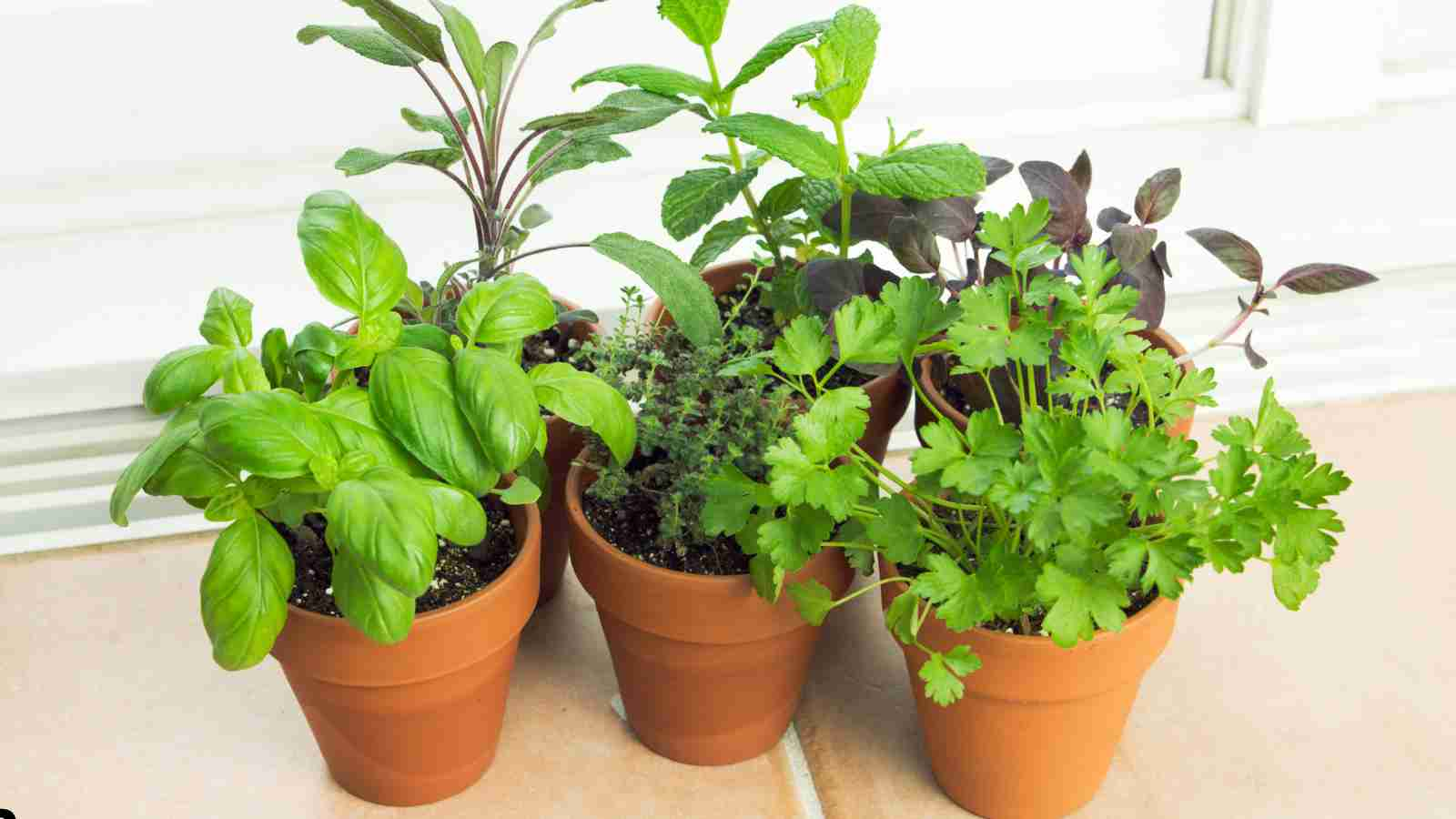
Indoor container gardening involves growing plants, including vegetables, fruits, herbs, and ornamental plants, inside containers or pots within a home environment.
This method allows individuals living in spaces without traditional garden areas, like apartments or homes with little to no yard space, to cultivate fresh produce and greenery. It’s an adaptable, space-efficient, and accessible way to garden.
Best Indoor Container Gardening Systems
There are several systems suitable for indoor container gardening that optimize space and encourage healthy plant growth. These include:
- Hydroponic Systems: These soil-free systems use a nutrient-rich water solution to grow plants faster than traditional soil gardening.
- Self-Watering Containers: Ideal for busy gardeners, these containers have reservoirs that allow plants to absorb water as needed, reducing watering frequency.
- Vertical Gardening Towers: These towers use vertical space efficiently and can accommodate multiple plants in a single footprint, perfect for small indoor areas.
Check out a selection we made of the top Indoor Container Gardening Systems below
Best Indoor Container Gardening Vegetables
Some vegetables thrive in indoor container environments due to their compact nature and lower light requirements. Below are a couple of examples, but these are not all the vegetables you can grow indoors. The variety of vegetables you can grow indoors also depends on the space you want to dedicate to indoor growing.
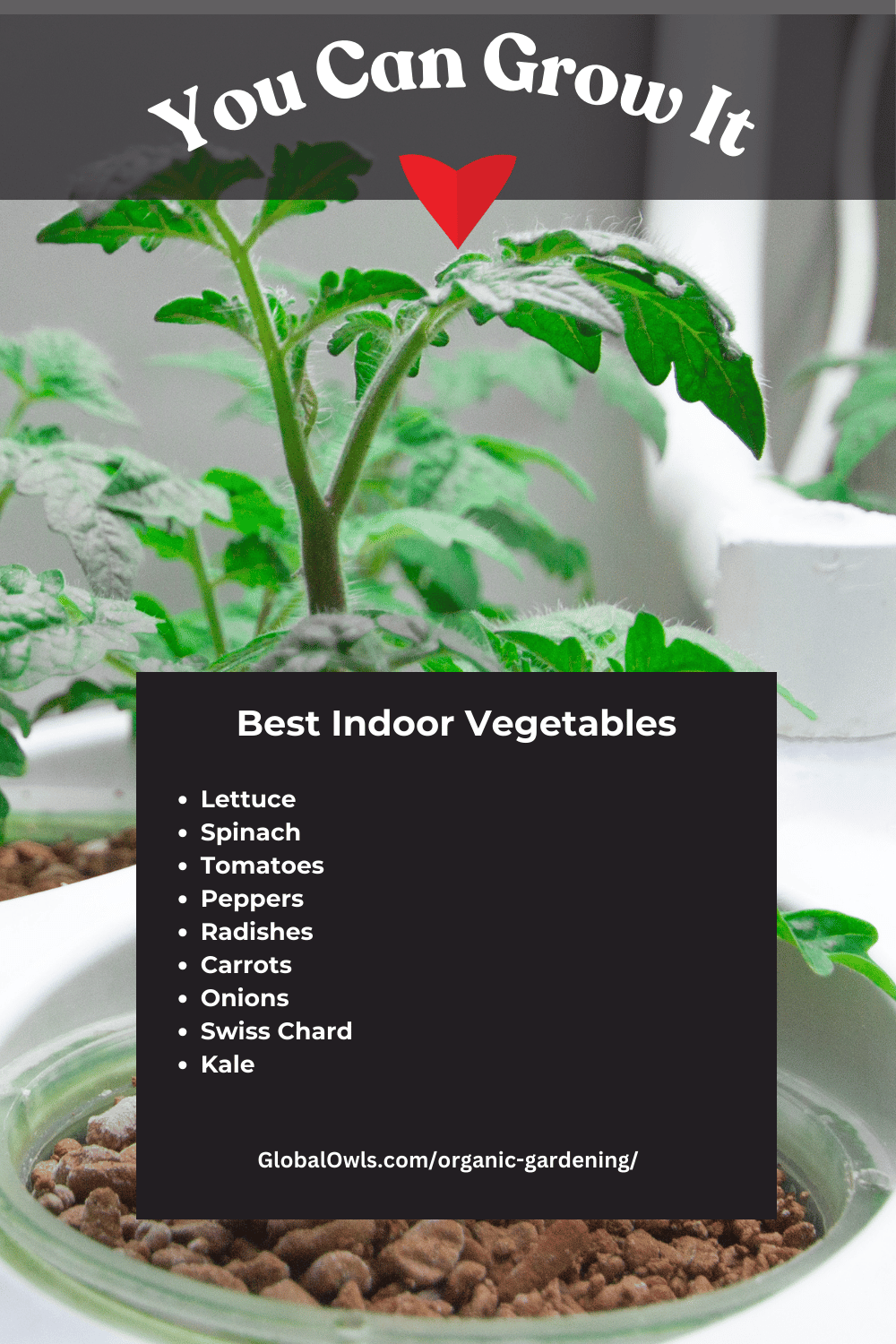
Indoor container gardening opens up a world of opportunities for growing vegetables inside your home. The key to success is choosing vegetables that are well-suited to the indoor environment, taking into account factors such as container size, lighting conditions, and maintenance requirements. Here’s a closer look at some of the best vegetables for indoor container gardening:
Growing Lettuce and Spinach Indoor
These leafy greens are ideal for indoor gardening due to their low light and space requirements. Lettuce and spinach can thrive in shallow containers or window boxes, as their root systems are not very deep. They prefer cooler temperatures, which makes them perfect for indoor settings away from direct, intense sunlight. For continuous harvest, practice “cut-and-come-again” harvesting, where leaves are picked as needed, allowing the plant to keep producing new growth.
- Light: Bright, indirect light or a grow light.
- Container Depth: 6-8 inches.
- Watering: Keep the soil consistently moist but not waterlogged.
- Harvest: As early as 4-6 weeks after planting.
Growing Tomatoes and Peppers Indoor
Dwarf or bush varieties of tomatoes and peppers are excellent for growing indoors as they can be managed within limited spaces. These plants do require more light to fruit properly, so a south-facing window or a supplemental grow light is necessary. Support for these plants, like stakes or small trellises, will help maintain their structure and support fruit production.
- Light: At least 6-8 hours of direct light or bright artificial light.
- Container Depth: At least 12 inches, with staking options.
- Watering: Water when the top inch of soil feels dry, and ensure good drainage.
- Harvest: Typically, tomatoes take about 60-80 days from transplant, while peppers can take 60-90 days depending on the variety.
Growing Radishes and Carrots Indoor
Root vegetables like radishes and carrots are also suitable for indoor container gardens, provided they are given deep enough containers to accommodate root growth. Radishes are particularly easy and quick to grow, making them a rewarding vegetable for beginners. Carrots require a bit more patience and a sandy, well-draining potting mix to facilitate proper root development.
- Light: Moderate to bright indirect light.
- Container Depth: At least 12 inches deep for carrots, and 6-8 inches for radishes.
- Watering: Maintain consistent moisture in the soil to support root growth and prevent splitting.
- Harvest: Radishes can be ready in as little as three to four weeks, while carrots typically take about 50-80 days.
Growing Green Onions (Scallions) Indoor
Green onions are ideal for indoor gardens because they require minimal space and can even be regrown from kitchen scraps. They grow quickly and don’t need deep soil, making them perfect for shallow containers.
- Light: Moderate to bright indirect light.
- Container Depth: 4-6 inches.
- Watering: Keep the soil evenly moist; green onions are fairly tolerant but thrive in moist conditions.
- Harvest: Ready to harvest in about 20-30 days after planting; you can also cut and leave the roots in the soil to regrow.
Growing Swiss Chard Indoor
Swiss chard is a colorful and robust leafy green that grows well indoors. Its vibrant leaves and stems can add a decorative touch to your space while providing a tasty and nutritious harvest.
- Light: Bright, indirect light or under grow lights.
- Container Depth: 8-12 inches.
- Watering: Maintain consistent moisture without overwatering, as chard prefers well-drained soil.
- Harvest: Leaves can be harvested from the outer part of the plant as early as 4-6 weeks, allowing the center leaves to continue growing.
Best Indoor Container Gardening Fruits
Growing fruits indoors can be just as rewarding as vegetables, especially when you choose varieties suited to container gardening and indoor conditions. Here are some fruit options that thrive in indoor environments, complete with care tips for each:
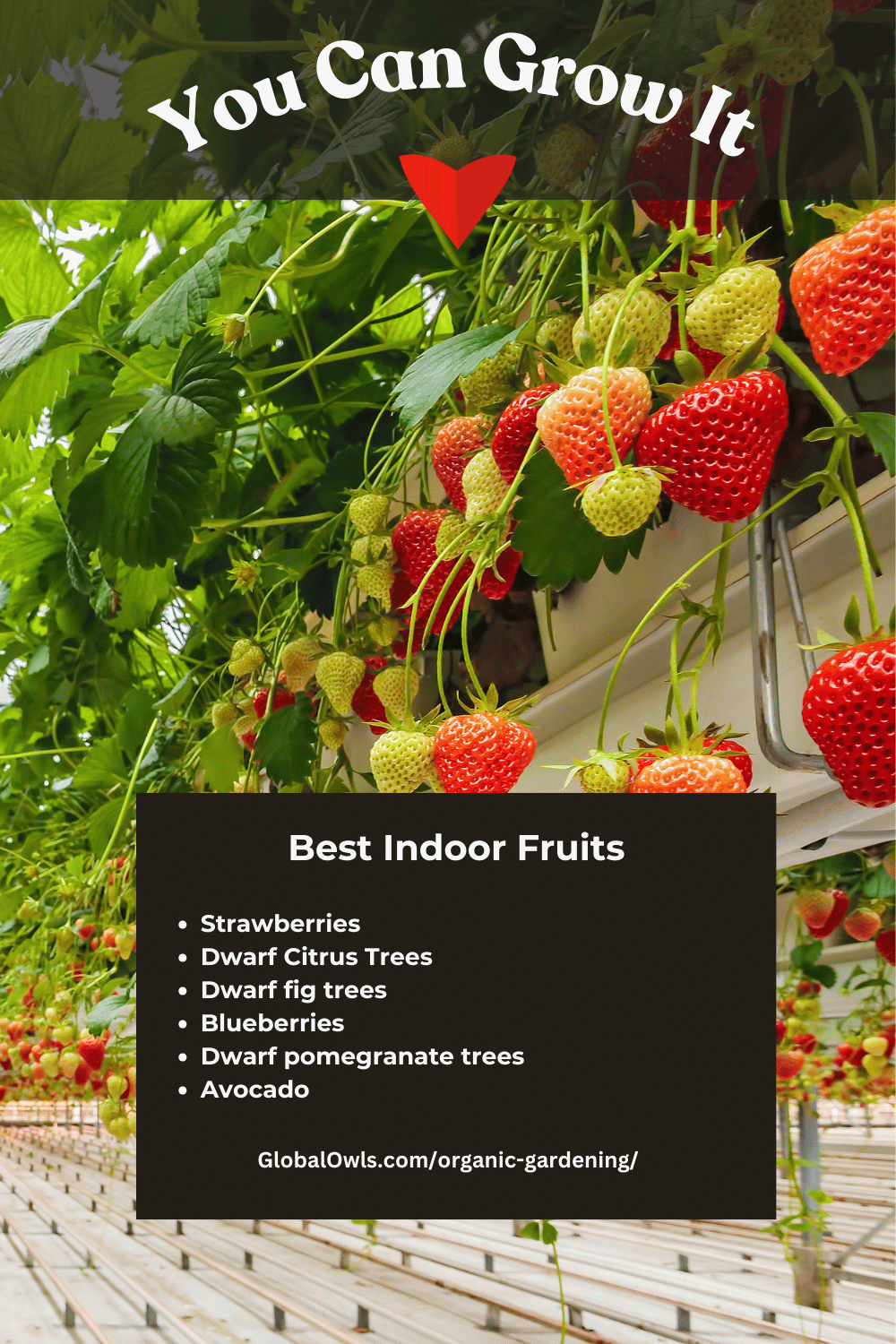
Growing Strawberries Indoor
Strawberries are one of the most popular fruits for indoor gardening due to their compact nature and the availability of varieties that can flourish in containers. They can produce fruit with adequate light and care.
- Light: Bright direct light or a grow light, ideally for at least 6-8 hours per day.
- Container Depth: 8-12 inches in a wide pot or hanging basket.
- Watering: Keep the soil consistently moist but not soggy; good drainage is crucial.
- Harvest: Strawberries can start to produce fruit 3-6 months after planting, depending on the variety and season.
Growing Dwarf Citrus Trees Indoor
Dwarf varieties of citrus trees, such as lemons, limes, and oranges, can be grown indoors. They need bright light and regular care but can be very productive, even indoors.
- Light: Bright, direct sunlight for at least 6-8 hours daily or supplemented with a high-intensity grow light.
- Container Depth: 12-18 inches; ensure the pot is large enough to accommodate the root system and has good drainage.
- Watering: Water deeply but infrequently, allowing the top inch of soil to dry out between watering.
- Harvest: Fruits generally mature in 6-12 months, depending on the species and environmental conditions.
Growing Figs Indoor
Dwarf fig trees are another excellent option for indoor gardening. With adequate light and care, they can produce sweet figs even indoors.
- Light: Plenty of bright, indirect sunlight or under grow lights.
- Container Depth: 12-20 inches; larger pots will provide stability for the growing tree.
- Watering: Water when the topsoil feels dry but maintain consistent moisture during the growing season.
- Harvest: Figs usually begin to fruit within one to two years of planting.
Growing Blueberries Indoor
Growing blueberries indoors requires some attention to soil acidity, as they thrive in acidic conditions. Dwarf varieties are best suited for container growing.
- Light: Bright, indirect light or supplemented with artificial light.
- Container Depth: 12-18 inches, with a wide pot to accommodate bushy growth.
- Watering: Keep the soil consistently moist and acidic, pH around 4.5 to 5.5. Use a pine bark mulch to help maintain acidity.
- Harvest: Blueberries can take a few years to start producing fruit, but once they do, you can enjoy berries every season.
Growing Pomegranates Indoor
Dwarf pomegranate trees are well-suited for indoor growth due to their manageable size and ornamental beauty. They also produce edible fruit, which is a bonus.
- Light: Full sun, ideally through a south-facing window or supplemented with a grow light.
- Container Depth: 10-15 inches, ensuring the container is broad enough for the plant’s root system.
- Watering: Water deeply but allow the soil to dry slightly between waterings.
- Harvest: Fruits usually mature in the late fall, about 6-7 months after flowering.
These fruit options not only enhance the aesthetics of your indoor space but also offer the satisfaction of growing your own healthy snacks right at home. By providing the right conditions and care, you can enjoy a variety of fresh fruits year-round from your indoor garden.
Best Indoor Container Gardening Herbs
Growing herbs indoors is not only convenient for cooking but also enhances your living space with fresh scents and greenery. Here’s a guide on some popular herbs that thrive in indoor container gardens, along with their specific care requirements:
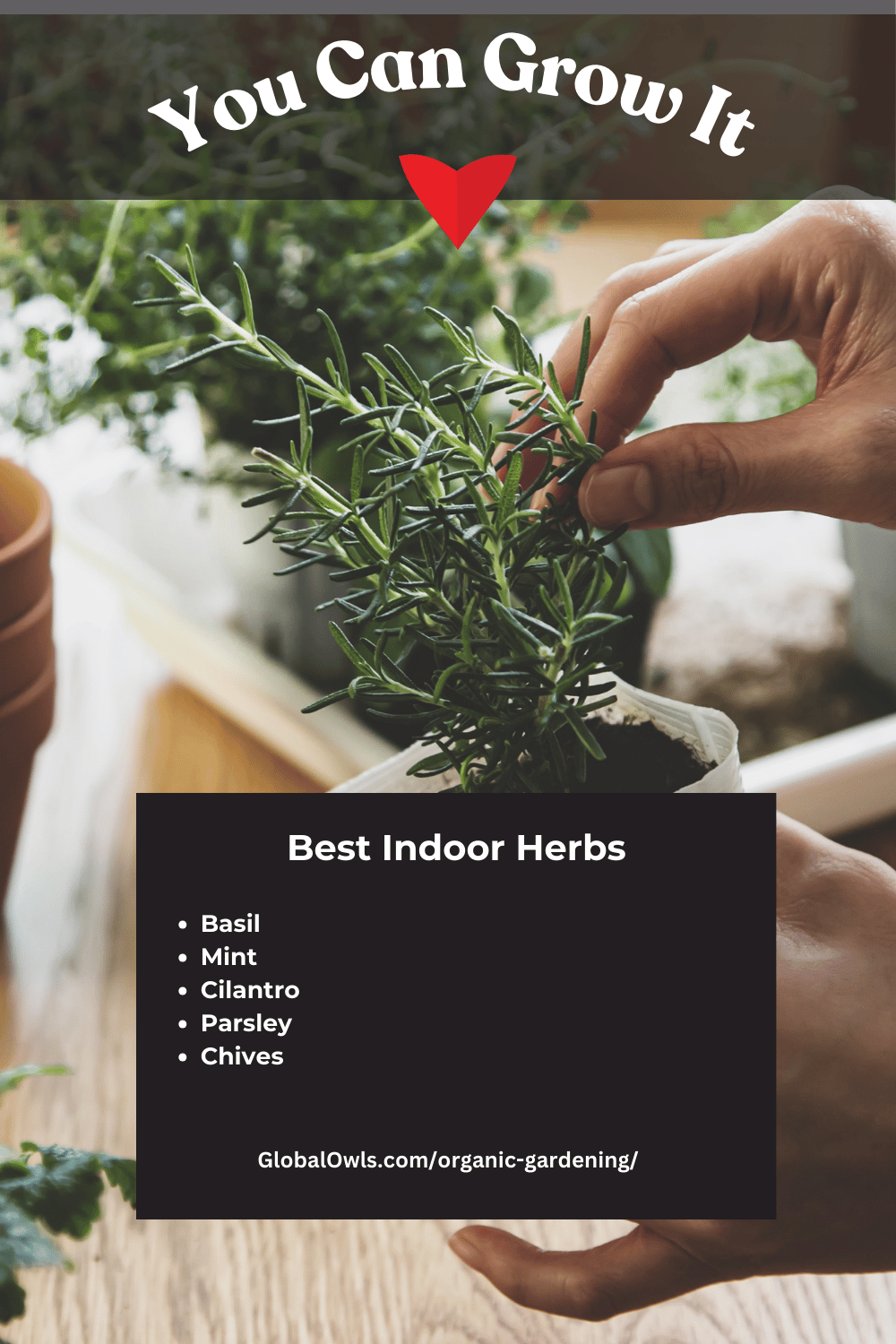
Growing Basil Indoor
Basil is a favorite among indoor herb gardeners due to its fast growth and usefulness in many dishes. It requires a bit of care but rewards you with abundant, flavorful leaves.
- Light: Basil needs at least 6-8 hours of direct sunlight per day, so a sunny windowsill or a grow light is ideal.
- Container Depth: 8-12 inches. Basil does not have a deep root system but prefers room to spread.
- Watering: Keep the soil consistently moist but not soggy. Basil does not like to dry out completely.
- Harvest: Regular harvesting of the top leaves can encourage a bushier growth and prevent the plant from flowering, which diminishes the flavor of the leaves.
Growing Mint Indoor
Mint is highly adaptable and easy to grow, making it perfect for beginners. It can be invasive, so keeping it in a container indoors is a great way to manage its spread.
- Light: Prefers bright, indirect light but can tolerate some shade.
- Container Depth: 10-12 inches. Mint spreads through runners, so wider is better than deeper.
- Watering: Likes moist soil, so regular watering is necessary to keep the soil evenly damp.
- Harvest: Mint leaves can be picked as soon as the plant is established and grows vigorously. Regular harvesting helps control its growth and encourages new leaves.
Growing Cilantro Indoor
Cilantro grows quickly from seeds and is another essential herb for culinary use, especially in Asian and Latin American dishes.
- Light: Requires about 4-5 hours of direct sunlight per day.
- Container Depth: 8-10 inches, as cilantro has a long taproot.
- Watering: Keep the soil moist but not waterlogged, as cilantro does not like dry soil.
- Harvest: Harvest leaves once the plant is 6 inches tall by cutting the outer leaves, which will encourage further growth.
Growing Parsley Indoor
Parsley is a versatile herb used in many dishes, and it grows well indoors with proper care.
- Light: Needs at least 5-6 hours of sunlight per day.
- Container Depth: 10-12 inches to accommodate its deep roots.
- Watering: Likes consistently moist soil. Water when the top inch of soil starts to dry out.
- Harvest: Like cilantro, parsley can be harvested by cutting the outer leaves, allowing the inner leaves to continue growing.
Growing Chives Indoor
Chives are a low-maintenance herb great for indoor gardens. They provide a mild onion-like flavor to dishes.
- Light: Requires at least 4-6 hours of direct sunlight.
- Container Depth: 6-8 inches is sufficient, as chives have a shallow root system.
- Watering: Keep the soil moist but well-drained. Chives are not overly demanding about water but don’t like to be too dry.
- Harvest: Cut the leaves with scissors about an inch above the base of the plant. They will regrow quickly.
These herbs can be grown together in larger containers or separately in smaller ones, depending on your space and aesthetic preferences. Each herb has unique requirements but generally, they all thrive with good light, sufficient water, and regular harvesting to promote fresh growth.
Indoor Container Gardening Tips
To successfully maintain an indoor container garden, consider the following tips:
- Lighting: Ensure plants get enough light, either through natural sunlight or supplemental grow lights.
- Watering: Monitor soil moisture closely; overwatering is a common issue in indoor gardening.
- Temperature and Humidity: Maintain a consistent indoor environment without extreme temperature fluctuations. Use humidifiers or misters if necessary.
Indoor Container Garden Ideas
Get creative with how you set up your indoor garden. Check out Amazing Indoor Gardening Ideas:
- Edible Window Boxes: Transform sunny window sills into productive spaces with herbs or small vegetables.
- Living Walls: Use vertical planters to grow a mix of ornamentals and edibles, creating a living piece of art.
- Themed Plant Collections: Create themed indoor gardens, such as a Mediterranean herb collection or a tropical fruit corner, depending on light availability and space.
Conclusion
Indoor container gardening offers a unique and satisfying way to engage with nature from the comforts of your own home. By understanding the essentials laid out in this guide—from choosing the right gardening systems to selecting the best plants for indoor conditions—you can transform your living space into a vibrant oasis of greenery and freshness. As you embark on this gardening journey, remember that each plant has its own needs and rewards. With patience, care, and creativity, your indoor container garden will grow to become a source of pride and joy, providing not just aesthetic enhancement but also a continuous bounty of fresh produce.
FAQ
What is indoor container gardening?
Indoor container gardening involves growing plants inside your home in containers such as pots, planters, or even recycled materials. This method is ideal for those with limited outdoor space or who want to enjoy greenery inside their home.
What are the best plants for indoor container gardening?
Some of the best plants for indoor container gardening include succulents, spider plants, peace lilies, snake plants, and herbs like basil and mint. These plants are generally low-maintenance and adapt well to indoor environments.
What type of containers should I use for indoor gardening?
Containers for indoor gardening can be made of plastic, ceramic, metal, or wood, provided they have drainage holes to prevent waterlogging. The size and material of the container should suit the specific needs of the plants you choose to grow.
How do I choose the right soil for indoor container plants?
Use a high-quality potting mix specifically designed for indoor plants. These mixes are formulated to provide proper drainage and nutrient retention suitable for container environments.
How much light do indoor container plants need?
The amount of light needed varies by plant species. Most indoor plants require bright, indirect light. Some, like succulents, may need direct sunlight, while others, such as ferns, thrive in low-light conditions.
How often should I water plants in indoor containers?
Watering frequency depends on the type of plant, the size of the container, and the indoor environment. Generally, it’s best to water when the top inch of soil feels dry. Overwatering is a common issue in indoor gardening, so ensure proper drainage.
What are common pests in indoor container gardening, and how can I manage them?
Common pests include gnats, spider mites, and aphids. Manage them by keeping the foliage clean, using insecticidal soap, or introducing natural predators like ladybugs.
Can I grow vegetables and fruits in indoor containers?
Yes, many vegetables and fruits can be grown indoors, such as tomatoes, peppers, strawberries, and dwarf varieties of fruits like citrus trees. Ensure they are placed in a location that receives adequate light and care.
What are the benefits of indoor container gardening?
Benefits include improving indoor air quality, enhancing mental well-being, adding aesthetic appeal to your home, and providing the satisfaction of growing your own food or decorative plants.
How can I fertilize my indoor container plants?
Fertilize indoor container plants with a water-soluble fertilizer according to the package directions, typically every 4-6 weeks during the growing season. In winter, reduce fertilization as plant growth slows down.
How do I choose the best location for my indoor container garden?
Choose locations with adequate light based on the needs of your specific plants. South or west-facing windows are ideal for plants requiring bright light, while east or north-facing windows are better for plants that thrive in lower light conditions.
What is the best way to increase humidity for indoor plants?
To increase humidity, use a humidifier, place a water tray with pebbles near your plants, or group plants together to create a microenvironment with higher humidity. Misting plants regularly can also help, though it’s less effective than other methods.
Can I use outdoor soil for my indoor container garden?
It’s not recommended to use outdoor soil for indoor plants as it may contain pests, weeds, and diseases. Outdoor soil can also be too heavy and may not allow adequate air and water flow for indoor plant roots.
How can I ensure proper drainage in indoor container plants?
Ensure your containers have drainage holes at the bottom. Place a layer of pebbles or broken pottery at the base of the container before adding soil to help prevent the drainage holes from getting blocked.
What should I do if my indoor plant outgrows its container?
If a plant outgrows its container, repot it into a larger container with fresh potting mix. Choose a container that is one size larger than the current one to ensure adequate room for growth without overpotting.
How do I prune indoor container plants?
Regularly prune indoor plants to remove dead or yellowing leaves and to promote bushier, healthier growth. Use clean, sharp scissors or pruning shears to make cuts just above leaf nodes.
Are there any specific challenges to growing herbs indoors?
The main challenges of growing herbs indoors include providing enough light and managing water requirements. Herbs typically need at least 6 hours of sunlight a day, so a sunny windowsill or artificial grow lights are essential.
How can I decorate my home with indoor container plants?
Use a variety of container styles and plant types to create visual interest. Consider hanging planters, wall-mounted pots, or tiered plant stands. Coordinate the colors of the containers with your home décor for a cohesive look.
What are some low-maintenance plants for beginner indoor gardeners?
Low-maintenance indoor plants ideal for beginners include pothos, snake plant, ZZ plant, and spider plant. These plants require minimal care and are forgiving of occasional neglect.
How can I prevent diseases in my indoor container garden?
Prevent diseases by ensuring good air circulation around plants, avoiding overcrowding, and keeping leaves dry during watering. Regularly inspect plants for signs of disease and isolate any affected plants to prevent spread.
How do I manage soil compaction in indoor container plants?
To manage soil compaction, periodically loosen the soil gently with a fork or your fingers, being careful not to damage the roots. Additionally, repotting plants into fresh soil every few years can help prevent compaction and rejuvenate plant growth.
What type of lighting is best for indoor container gardening?
LED grow lights or fluorescent bulbs are ideal for indoor gardening as they provide a broad spectrum of light, mimicking natural sunlight. Position lights about 6-12 inches above the plants, adjusting as they grow.
Can indoor container plants help improve air quality?
Yes, many indoor plants can improve air quality by absorbing toxins and producing oxygen. Plants like spider plants, peace lilies, and Boston ferns are especially effective at filtering indoor air.
What are the best practices for watering indoor container plants?
Water indoor container plants when the top inch of soil feels dry. Use lukewarm water and water thoroughly until it drains out of the bottom of the pot. Avoid letting plants sit in water, as this can lead to root rot.
How do I choose containers with the right size for my indoor plants?
Choose containers that are 1-2 inches larger in diameter than the current pot for small plants, and 2-4 inches larger for bigger plants. This provides enough space for root growth without waterlogging, which can occur in oversized pots.
What is the easiest way to propagate indoor plants?
Many indoor plants can be easily propagated by cuttings. Snip a segment of stem or leaf, allow it to callous or root in water, then plant it in soil. Common plants for easy propagation include pothos, philodendrons, and succulents.
How can I create a vertical garden indoors using container plants?
Create a vertical garden by using wall-mounted planters, hanging baskets, or freestanding vertical planter systems. This can be a space-saving way to grow herbs, ferns, or small vegetables indoors.
What minerals are essential for indoor container plant health?
Key minerals for plant health include nitrogen for leaf growth, phosphorus for root and flower development, and potassium for overall vitality. Trace minerals like iron, magnesium, and calcium also play critical roles.
How do I deal with leaf drop in indoor container plants?
Leaf drop can be caused by stress from overwatering, under watering, low humidity, or insufficient light. Adjust the care accordingly, ensuring that you provide the right environment based on the plant’s specific needs.
What are some creative indoor container gardening ideas?
Use unconventional containers like mason jars, teacups, or old books cut into to house plants for a unique look. Incorporate different levels and types of plants to create depth, such as tall snake plants behind cascading pothos.
